chapter 14:
The Civil War was significantly impacted by technology, particularly railroads and more accurate guns. Maxim's invention of the first machine gun grew out of civil war experiments. Yet when World War I came the U.S. found itself behind in military technology.
World War I started in 1914, US entered April 1917, Armistice Dec. 1918.
- The war quickly settled down to a trench warfare (photo) stalemate due to the use of machine guns and barbed wire--technology seemed to be the only way out.
- as well as airplanes and poison gas, tanks and submarines were developed into useful weapons
- The war therefore led to the first major wartime efforts to develop technology for military use

French tank
- A few months after the war began the French apparently used gas against the Germans and the Germans retaliated in kind.
- In the 9th month of the war the Germans released a cloud of chlorine gas--which causes choking--on French troops who retreated in panic, leaving behind perhaps 5,000 dead. A four mile gap in the line was opened, but the Germans had not brought forward enough reserves to exploit it and the Allies repaired the break.
- At first troops wore makeshift masks of handkerchiefs wetted with urine and tied over nose and mouth.
- Germany was widely criticized for breaking the Hague
Conventions of 1899.
- In mid-1915 Germans started using phosgene, which causes severe lung damage, and both sides developed gas masks.
- By the end of 1916 a variety of weapons were in use by both sides. Germans introduced mustard gas--could cause burns to exposed skin even when a soldier was protected by a mask.
- This quickly became a research race. It started with the US Bureau of Mines working on adapting mining equipment.
- A central lab was created in fall 1917 at American University--at peak employed 1200 scientists. Developed a new gas--Lewisite, that poisoned through the skin, simpler ways of producing mustard gas, and more
- Chemical Warfare Service created July 1918--university chemists and Bureau of Mines personnel were given commissions.
- In all as many as 50 different gases were used--poison-gas causalities 1.3 million with 92,000 deaths.
- After the war chemists were proud of their contribution to the nation--wanted ongoing research. Argued that chemical weapons were humane (and effective) because they disabled soldiers rather than killing them. They didn't get the continuing high level of research they wanted.
- A strong reaction against the use of gas took over instead. The Geneva Protocol--an international protocol signed in 1925 prohibiting the use in war of "asphyxiating, poisonous and other gasses" and of "bacteriological methods of warfare."
- The treaty held through World War II but use of poison gas
is a difficult issue today. Fear becomes an issue even when it is
not used: seven
Israelis suffocated to death due to improper use of gas masks during
Iraqi attacks in the Gulf War.
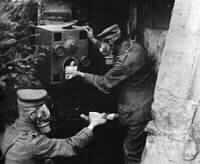
German signal corps soldiers placing their carrier pigeons in a shelter during a gas attack
The airplane had been invented in the U.S., but the army had shown very little interest in its military potential.
- European countries had done much more, and in 1915 the U.S. realized it was behind and created an organization called the National Advisory Committee for Aeronautics to jump-start the production of military aircraft.
- forced a patent pool--Manufacturers Aircraft Association--to allow the best technologies to be used
- the Curtis Company designed a training plane, the JN-4, but battle planes were built on a British design
- all of the countries involved struggled to figure out how to make effective use of aircraft--new strategies had to be developed by pilots and integrated by generals
- mass production of aircraft was well underway in the U.S. when the war ended--2091 planes had been shipped to France and 1041 were awaiting shipment
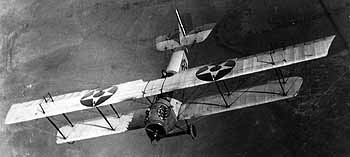
Curtis JN-4 Aircraft, World War I
- Thomas Edison said he had a plan for preparedness but that he was reluctant to discuss the terrible devices he had in mind. War could be mechanized with labor-saving devices
- In 1915 the Navy established the Naval Consulting Board
- the board was to consist of "Civilian Experts on Machines" who would originate ideas and critically examine ideas submitted by others--11 professional societies each named two members. These were engineers and business leaders, not scientists
- the Board had a big fight about building its own laboratory, but the laboratory that was eventually built continued after the war as the Naval Research Laboratory
- the effort that got the most public attention was a plan to screen inventions submitted by the public--Edison believed that American inventors could win the war
- 110,000 inventions were submitted, 110 deemed worthy of development, only one reached production--an aircraft simulator invented by W. Guy Ruggles
- one of the Board's largest projects was trying to find new methods of submarine detection
- they also sponsored research on gyroscopic stabilization, leading to the first primitive autopilots for aircraft (Lawrence Sperry proved they didn't work too well--at least not well enough for the pilot to get romantic instead of flying the plane)
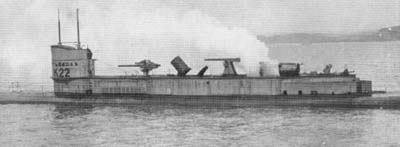
World War I British Submarine
- Scientists wanted to show how valuable science is: George Ellery Hale (an astronomer) wrote: "I really believe this is the greatest chance we have ever had to advance research in America"
- they also focused on the problem of submarine detection--German U-Boats sunk over a million tons of Allied and neutral merchantment in the first quarter of 1917
- the NRC brought in professors from universities to work on the problem
- a young mathematician named Max Mason had the idea of a listening device that could focus sound--he build something that looked like a trombone
- the final device had a range of 3 miles and was very successful. Similar technology was developed for artillery ranging
- scientists felt they had proved the scientific research approach to developing new technology
Chapter 15:
The nice neat scientific world that had seemed possible in the 19th century was replace in the 20th with quantum mechanics, relativity, and nuclear physics
- atoms no longer were nice neat little particles
- space and time were relative
- matter could be made into energy and one element could be made into another--it was possible but not practical to make lead into gold (the goal of medieval alchemists)
- Henri Becquerel discovered radioactivity as a property of uranium in 1896, Marie Curie discovered other radioactive elements
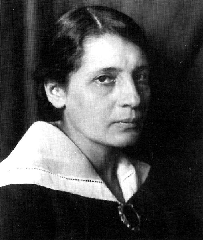
Lise Meitner
- Otto Hahn , Lise Meitner, and O.R. Frisch worked in the 1930s to understand the results of bombarding uranium with neutrons--realized that the uranium fissioned.
- by 1939 it was obvious and widely know that a chain reaction might be possible because each atom that fissioned released neutrons that could hit other atoms and cause them to fission
- Refugee scientists in the U.S. feared a German bomb. Leo Szilard composed two letters for Einstein to sign warning President Roosevelt of the dangers of a German atomic bomb, one in August 1939 and the other in April 1940. Fear was widespread enough that U.S. and British journals volunarily censored related scientific papers.
- Germans were indeed working on a bomb, but got stuck in a dead end. Supporters of Werner Heisenberg say he did this on purpose.
- First organized under National Defense Research
Committee (approval for project Oct. 1941) then turned over to the army
in June 1942. The army put General Leslie Groves in
charge.
- The first thing to do was prove a chain reaction was possible. That effort was led by Enrico Fermi , first at Columbia then at the University of Chicago. The first successful chain reaction took place Dec. 2, 1942 in a small reactor built in a squash court at the Univ. of Chicago.
- Providing fuel for the bomb was a tremendous technical challenge--must separate uranium-235, which is less than 1% of the uranium mined and differs in weight by only .13%. Two methods of separation: a cyclotron and gaseous diffusion of uranium hexaflouride (the only gaseous compound, but one that is both poisonous and corrosive) were set up at Oak Ridge , Tenn., using TVA power. The other alternative is to make plutonium by chain reactions--reactors to do this were built in Hanford, Washington.

K-25 gaseous diffusion plant at Oak Ridge
- Robert Oppenheimer led the effort to design the bomb and said he needed to bring scientists together at a single laboratory. Los Alamos opened in March 1943. Developed two bomb designs, one using uranium and one using plutonium. The plutonium design was tested in the Trinity test near Alamogordo NM on July 16, 1945. Exploded with the force of 20,000 tons of TNT.
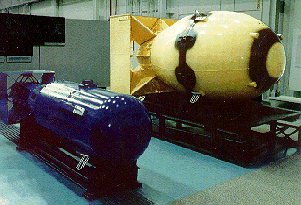
Bombs used in Japan
( good links on the decision )
- Germany was clearly defeated and the Japanese were retreating--was it necessary to use the bomb?
- Could there have been a demonstration and warning instead? Would it have been used in Europe or was racism a factor?
- After spending $2 billion would the goverment have been accused of wasting money if it wasn't used?
- when Roosevelt died on April 12, 1945, the bomb project was so secret that Vice President Harry Truman didn't even know about it. The bomb was used because having built it everyone assumed that having built it they would use it.
- three B-29 bombers set out for Hiroshima , Japan on Aug. 6, 1945. The Japanese sounded the all-clear when they saw only 3 planes. The Enola Gay dropped the 5 ton bomb and it exploded with the force of 15,000 tons of TNT. 130,000 people died within 3 months, 68% of the buildings of the city were destroyed.
- A plutonium bomb was dropped on Nagasaki on Aug. 9, 1945. Exploded with the force of 22,000 tons of TNT.
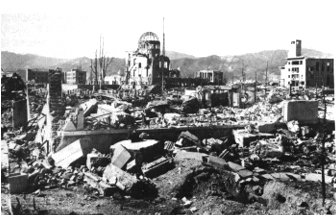
bomb damage in Hiroshima
The scientists tried to prevent an arms race from developing. Why did they feel so strongly, and did they have any hope of success?
People were frightened by the bomb and began to question the idea that technological progress was always good
- the cold war meant real fears that a nuclear war would start
- Hiroshima made vivid the dangers of radioactivity, leading to movies about mutant monsters
- young people in the 1960s began to reject the boring lives their parents had wanted after WWII
- Rachel Carson published Silent Spring in 1960, and public concern about environmental issues grew rapidly
- the Civil Rights Movement was showing the American people that you can change the wrongs of society
- Sputnik (the first artificial satellite) and computers started a new technological age
- Jules Verne's novel From the Earth to the Moon (1865), featuring a launch from a cannon in northeastern Florida
- Konstantin Tsiolkovsky's work (influenced by
Verne) in Russia on the theory of rocket propulsion?
- in 1903 he published a book titled Exploring
Cosmic Space with Reactive Devices in which he laid out the
mathematics of orbital mechanics and designed a rocket powered by
liquid oxygen and liquid hydrogen.
- Recognized many of the
problems, eg. burning up during reentry, and thought of multistage
rockets (which he called rocket trains).
- No attempt to
experiment--he received only one small grant.
- Saw spaceflight as liberation from human limits and the first step towards the perfection of human society.
- in 1903 he published a book titled Exploring
Cosmic Space with Reactive Devices in which he laid out the
mathematics of orbital mechanics and designed a rocket powered by
liquid oxygen and liquid hydrogen.
- Robert Goddard's theories (1919 treatise A
Method of Reaching Extremely High Altitudes), and experiments,
starting in 1926, with small, liquid-fuel rockets
- In 1930 Goddard set up full time resarch in New Mexico, attempting 41 launches, 31 of them successful, in the next 11 years. His largest rocket was 22 feet in length, fuilded with gasoline and liquid oxygen. After 1941 he couldn't get further support, and he died in 1945.
- He was much laughed at and couldn't take it, so he conducted his research privately, failed to build an organization, suffered from lack of support, and had little influence. He repeatedly failed to get military funding (on the grounds that the U.S. had no need for military rockets at that time), and while he received over $200,000 from foundations, it was on a year by year basis that made it difficult to undertake large projects. His fame came only when space travel began to look realistic--in 1960 the U.S. government awarded his family $1 million for the rights to use more than 200 of his patents.
- the roots of this development are in an society of amateur rocketers inspired by a German-speaking Rumanian schoolteacher and rocket theoretician, Hermann Oberth, who published The Rocket into Planetary Space in 1923
- The Society for Space Travel (VfR) was founded in 1927, with Oberth as its president

Society for Space Travel
- by 1929 it had 870 members, including Wernher von Braun, who had just graduated from high school.
- It had two goals: popularize the idea of flight to the moon and planets and perform serious experiments in rocket propulsion.
- Oberth was a classic incompetent theoretician (one of his colleagues said that if "Oberth wants to drill a hole, first he invents the drill press"), early efforts resulted in many explosions inclusing one that killed a member, Despite these problems, the society successfully launched 87 small liquid-fueled rockets in 1931 from an abandoned WWI ammunition storage facility (including one that set fire to a nearby police station). Experiments continued at a slowing rate until 1934, when the society went bankrupt
- Amateur research could only afford to go so far--the VfR was funding only by dues and admission charged to view launches. The leaders of the VfR promoted the idea of rockets as weapons in hopes of getting the funding they needed.
- The German army became interested in rockets in 1929 as a way of getting around the treaty of Versailles limits on the army
- In 1932 the German army assigned Walter Dornberger to look into liquid-fueled rockets, and he hired von Braun and a number of amateurs--but clearly to develop a weapon, not space travel
- This led to the building of the V-2 intermediate range ballistic missile, used against England.
- When the war was over von Braun arranged to to captured by the U.S. not the Soviet Union and said he wasn't a Nazi, he was only interested in space travel.

captured V-2 being prepared for launch
- U.S. cold war strategy was based on bombers carrying nuclear weapons. For one thing, it was cheap, and Truman and Eisenhower both were reluctant to increase the size of the government and distort the economy by large-scale defense spending. Substituting technological superiority for a large standing army put a new weight on being ahead
- Project RAND (an Air Force think tank) produced in May 1946 a report: "Preliminary Design of an Experimental World-Circling Spaceship" mentioned reconnaissance, weather, and communications
- In 1951 RAND scientists visiting Wright Field heard a briefing by James Lipp of Boston University's Physical Research Laboratory about using television for satellite reconnaissance. The key RAND reconnaissance people though the idea was ridiculous, and set out to disprove it with pictures taken at 30,000 feet with 8mm movie camera lenses mounted to a 35mm Leica camera loaded with coarse grain film and processed for poor resolution. The pictures showed streets and bridges, convincing Amrom Katz and others that satellite reconnaissance was feasible.
- the army had von Braun working on medium range ballistic missiles, the Air Force was working on the Atlas intercontinental ballistic missile, and the Navy's Naval Research Lab was doing a wide range of scientific research on rockets--but none of these had high priority or crash project funding
- Korean war led to more funding for
intercontinental ballistic missiles in 1951--Atlas--but with funding
only for a slow development process (at Convair--even in FY 1954 Atlas
got only $14 million). Only in 1954 was the decision make to give
it high priority

- What created stronger interest in the Department of Defense was not only fears of intercontinental ballistic missiles but the lure of spy satellites.
- Balloon reconnaissance over the Soviet Union began in 1956--243 balloons were never heard from again and only 44 were successfully recovered (the Soviets put some on display in Moscow and showed pictures of an air base in Turkey they said they had found on the film carried by one of the balloons)
- The U-2 was approved in 1954, designed by Kelly Johnson and the Lockheed Skunk Works in 80 days, and first used in 1956.
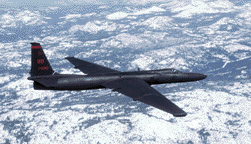
U-2
- One of the key problems for an open state competing with a closed one was information. You could do it with aircraft--U-2, but only at substantial risk--a U-2 was shot down over the Soviet Union in 1960, creating a major diplomatic incident. This proved to be how rockets and particularly launching satellites finally got substantial support
- But this raised an interesting dilemma--it wasn't a race for a spy satellite but an idea for something the Soviets didn't need and wouldn't like
- Eisenhower insisted that the project be peaceful rather than military. For one thing, this reflected his attempt to avoid a military-dominated state.
- this may also have been a strategy to establish the legitimacy of satellite overflight. Where do air rights end?--how to establish open skies in international law
- one way to do it is to launch a scientific satellite, preferably under international auspices (IGY). Far better that this be launched by the Navy's rocket built for scientific research than by what would clearly be a ballistic missile (then it would just look like a military test)
- or, you can let the Soviet Union launch first and not complain when their satellite goes over the U.S.--then they can hardly complain when a U.S. satellites goes over them
- The Naval Research Lab's Vanguard program was chosen for the first launch in a close vote by a panel of experts (on the basis of a better satellite) to launch the first satellite instead of von Braun's Redstone/Jupiter (which could have reached orbit in a test flight in Sept. 1956 if it had had a live upper stage). This was probably not a political decision, but it was on the basis on science, not a race with the Russians
- What is clearly political is that the DoD and Eisenhower went along with that choice, knowing that it almost surely meant that the USSR would launch first
- And they did, launching Sputnik 1 on October 4, 1957

Sputnik 1
- This lead to a large public furor and the creation of the National Aeronautics and Space Administration
- goal: to orbit and recover a manned satellite at the earliest practical date and to investigate the capabilities of man in this environment
- configuration: a ballistic capsule with high aerodynamic drag to be landed with parachutes
- the Atlas ICBM was the most reliable available booster system (although not tested successfully until Nov. 1958), but expensive ($2.5 million each) and not yet available, so testing was done with a cluster of solid rockets called little Joe and with Redstone
- In Dec. 1958 Eisenhower decided to draw astronaut candidates only from the pool of military test pilots (for security reasons, for one thing). The education requirement was reduced to bachelors degree or equivalent and test pilot school.
- Testing of astronaut candidates started in early 1959 from a pool of 110 qualified pilots. 32 were selected on the basis of written and psychological tests for physical testing. This testing followed a pattern set up for the Manhigh research balloon program--very detailed medical testing to ensure good health and establish a baseline and environmental tests. 18 of the 31 were recommended without medical reservations. They went into a program of training and participation in system design
- the first unmanned test of the Mercury capsule with the Atlas booster was held July 29, 1960. One minute after lift-off telemetry showed a complete loss of pressure in fuel tanks, then telemetry was lost. The booster was in the clouds at the time, but apparently it either exploded or suffered catastrophic structural failure.
- In Sept. 1960 an Atlas-Able carrying an early moon probe also failed severely, raising questions about the use of Atlas for Mercury which were particularly severe because of the pressures of an election year.
- There was a lot of press criticism that Mercury was not a crash program, but rather took things one step at a time with attention to budget and took second priority to the ICBM program.
- the first test of the Mercury-Redstone combination to be used to launch a person into ballistic flight was conducted on Nov. 21, 1960. The booster lifted 4 inches off the launch pad and then settled back down. The escape tower activated and took off, without the capsule, landing near the launch site and the capsule, still sitting on the booster, shot out its parachutes. Disarming the booster was not easy, but at least it was available for study to determine the cause of failure (a plug which disconnected unevenly, sending an abort signal).
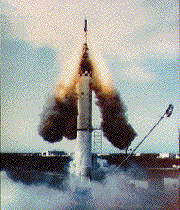
Mercury-Redstone 1
- on Dec. 19, 1960 a successful test of Mercury-Redstone was finally completed.
- the question of whether a human being could survive in space became unnecessary on April 12, 1961, when the Soviet Union launched Yuri Gagarin into orbit in a capsule weighing 3 times what Mercury weighed. No news of the flight was released until after recovery.
- on May 5, 1961, Alan B. Shepard, Jr., rode a Mercury-Redstone in a ballistic orbit into space on live TV
- safety of the Altas was such a concern that a chimpanzee named Enos was launched on Mercury Atlas 5 on Nov. 28, 1961. The machine to test his abilities under stress--pulling levers to receive a reward or avoid punishment--malfunctioned and he received shocks even when correct. He performed, but arrived on the ship hopping mad.
- after a series of delays John Glenn was finally orbited on Feb. 20, 1962, Scott Carpenter on May 24, 1962, Walter Schirra on Oct. 3, 1962, and Gordon Cooper on May 15, 1963 (observations of the earth).
- The Dec. 1960 PSAC Report had projected a manned
circumlunar flight about 1970, and a manned landing on the moon about
1975 at a total cost of $26 to 38 billion.
NASA included only circumlunar flight in its ten year plan, yet as early as mid-1959 NASA had identified a manned trip to the moon as a logical next step after putting people in space and had started the necessary planning. - Eisenhower refused to include money for Apollo
development in his 1962 budget, while at the same time he approved
development of an anti-satellite satellite
Meanwhile, Kennedy was elected in November 1960, having made a big fuss in his campaign about the missile gap (which did not in fact exist) - the first signs from the Kennedy administration were negative on space in general--NASA worried he would support the Air Force which wanted NASA to be replace by a military space program
- Kennedy's vice president, Johnson, had long been a major supporter of the space program
- Not until Jan 30 did Kennedy appoint a new NASA administrator, James Webb, who took office Feb. 14. But Webb was clearly an ambitious man
- April 12, 1961, Soviet Union launched Gagarin, and the U.S. was again embarrassingly behind
- at an April 14 meeting it became clear that
Kennedy wanted to accept the Soviet challenge, but was worried by the
cost
on April 17 a group of anti-Castro Cuban exiles, trained and financed by the U.S. invaded Cuba in what came to be called the Bay of Pigs fiasco because it was a total failure. - on April 19 Kennedy asked Johnson to find a "space program which promises dramatic results in which we could win. Johnson and the Space Council organized hearings to answer this question. concluded that there was no chance of beating the Russians in putting a multi-manned laboratory in space
- NASA said we could beat the Russians to the moon, and set 1967 as a target date. Accelerating the program would raise the cost from $22.3 billion to $33.7 billion
- Meanwhile, on May 5, 1961, Alan B. Shepard, Jr., rode a Mercury-Redstone in a ballistic tragectory into space, with live TV coverage. This was a reminder of what good press came from putting people in space
- Webb and Secretary of Defense MacNamara, with Johnson's blessing, wrote a memo entitled "Recommendations for our National Space Program: Changes, Policies, Goals." Called for a manned lunar landing before 1970, emphasizing national prestige and international competition
- Kennedy approved this as it stood--proposed a 61% increase in 1962 NASA budget
- On May 25, in a speech (listen to it all) entitled "Urgent National Needs" Kennedy said: "I believe that this Nation should commit itself to achieving the goal,before this decade is out, of landing a man on the moon and returning him safely to earth."
- the key point is that Apollo was a crash program--faster than even NASA had planned. The essential definition of a crash program is that different approaches are worked on in parallel
chapter 16:
Lessons Learned from WWII
- Basic science=power
- we can develop new technologies quickly to do whatever we want
- technology gives us dangerous power
- some policy issues require technical knowledge in order to
understand the issue
- wrote a prediction of the future in 1945--quite accurate except he missed completely the digital computer (much of his engineering research had been on analog computers)
- wrote a report later published as a book called: Science: The Endless Frontier
- his belief that the federal government should pay for basic scientific research led to the National Science Foundation
- he was critical of the manned space program on the grounds that it was too dangerous
- he understood that managing information was becoming a key problem
- renewed enthusiasm for progress
- accepting that the world is full of mystery instead of expecting to be able to control it all
- we will live in an "expanded" era
This
page written and copyright Pamela
E. Mack